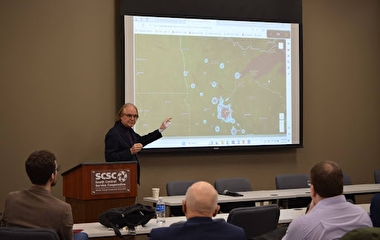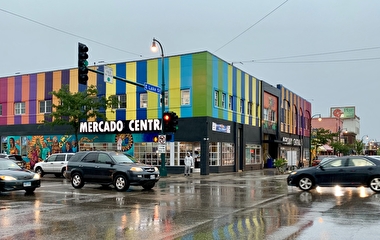Nighttime crashes at rural intersections are a major roadway safety concern. Rural intersection collisions account for 16 percent of all fatalities nationwide, with almost 30 percent of those fatalities occurring at night.
While previous research has shown the connection between an increase in lighting and a reduction in rural road nighttime crashes, little has been known about how the quality or quantity of that lighting affects nighttime crash rates.
In a recent project, University of Minnesota research fellow Chris Edwards confirmed that adding lighting to unlit rural intersections can significantly reduce nighttime crash rates, even when lighting levels are below national recommendations. In addition, he found that increasing lighting levels at lighted intersections can provide additional crash-reduction benefits.
“Though headlights provide some illumination of the forward roadway on rural roads, drivers may be more likely to overdrive if the only source of light is the headlight beam,” says Edwards, the study’s principal investigator, from the HumanFIRST Laboratory in the Department of Mechanical Engineering. “Adding roadway lighting at rural road intersections gives drivers additional, and otherwise low-contrast, visual information.”
Edwards began his work by identifying 63 intersection locations in six Minnesota counties. Working with Brian Davis, a research fellow in the Intelligent Vehicles Laboratory, Edwards drove a vehicle equipped with an advanced lighting data-collection system through the intersections to record the average illuminance level at each location.
Following data collection, Edwards analyzed the data using a series of models to assess the lighting level in conjunction with the nighttime crash ratio, intersection configuration, and the proximity of an intersection to a curve in the roadway.
“Our models demonstrated that intersection lighting produces major safety benefits,” says Edwards. “The biggest impact comes from adding lighting to an unlit intersection, which can reduce the ratio of nighttime-to-daytime crashes by more than 90 percent.” In addition, the team found that across all intersections, a one-unit increase in average illuminance (1 lux/0.1 footcandle) can reduce nighttime crash rates by 9 percent, and that at lighted intersections, a one-unit increase from average illuminance (1-lux/0.1 fc) can reduce crashes by 20 percent.
The research also indicates that lighting at rural road intersections produced significant safety benefits despite the fact that only 5 of the 37 lighted intersections met the minimum lighting levels set by national organizations. (The project’s lighting measurement area for an intersection differed from that currently used for national recommendations, which likely contributed to the variance in research results.) “The bottom line is that some lighting is better than no lighting at rural intersections,” Edwards says.
The collaboration with the Minnesota Department of Transportation (MnDOT) and the Minnesota Local Road Research Board (LRRB), the project’s sponsors, will position Minnesota to be a leader in rural roadway lighting research, Edwards says. “We hope that we can continue to investigate the lighting levels needed to achieve maximum safety benefits in the most cost-effective way. Having the lighting measurement data-collection system and teaming with the innovative minds at MnDOT and LRRB, we will achieve these goals.”
“This study helps validate the safety impacts that lighting can have on an intersection,” says Sue Zarling, MnDOT traffic electrical systems engineer. “MnDOT will continue to look at intersection lighting as one method of improving safety on our roads.”



